INSTITUT SUPERIEUR INSTITUT SUPERIEUR D'ANTHROPOLOGIE
INSTITUT OF ANTHROPOLOGY
COURS ONLINE – COURS A DISTANCE
INSCRIPTIONS OUVERTES
REGISTER NOW
RUSSIE –  Chagyrskaya - Two Neanderthals had their DNA tested, and the results showed traces of the papillomavirus (a sexually transmitted virus) and the adenovirus (adenovirus, which causes cold sores), as well as other viruses. The two prehistoric humans were male and their remains were found in a cave in Russia. Experts have long speculated that viruses may have caused the extinction of Neanderthals, and this most recent discovery could support that theory. This suggests that Neanderthals may have been infected with the same viruses that affect humans today, according to the authors of a preprint that has not yet undergone peer review. It also shows that it was possible to identify portions of viral genomes in archaeological samples. Adenoviruses, for example, can cause a wide range of illnesses from the pain in the butt that is the common cold, to a nasty bout of acute gastroenteritis. The overwhelmingly prevalent Epstein-Barr virus that can trigger mononucleosis and multiple sclerosis belongs to the herpesviruses. Papillomaviruses are perhaps best known for their association with cervical cancer. The team who made the discovery now plan to try and synthesise the “Jurassic Park-like viruses” to see how they compare to modern ones. “These Jurassic Park-like viruses could then be studied for their reproductive and pathogenic traits and compared to present-day counterparts,’ Marcelo Briones, the study’s lead author told NewScientist.
Chagyrskaya - Two Neanderthals had their DNA tested, and the results showed traces of the papillomavirus (a sexually transmitted virus) and the adenovirus (adenovirus, which causes cold sores), as well as other viruses. The two prehistoric humans were male and their remains were found in a cave in Russia. Experts have long speculated that viruses may have caused the extinction of Neanderthals, and this most recent discovery could support that theory. This suggests that Neanderthals may have been infected with the same viruses that affect humans today, according to the authors of a preprint that has not yet undergone peer review. It also shows that it was possible to identify portions of viral genomes in archaeological samples. Adenoviruses, for example, can cause a wide range of illnesses from the pain in the butt that is the common cold, to a nasty bout of acute gastroenteritis. The overwhelmingly prevalent Epstein-Barr virus that can trigger mononucleosis and multiple sclerosis belongs to the herpesviruses. Papillomaviruses are perhaps best known for their association with cervical cancer. The team who made the discovery now plan to try and synthesise the “Jurassic Park-like viruses” to see how they compare to modern ones. “These Jurassic Park-like viruses could then be studied for their reproductive and pathogenic traits and compared to present-day counterparts,’ Marcelo Briones, the study’s lead author told NewScientist.
Oldest Known Human Viruses Discovered In 50,000-Year-Old Neanderthal Remains - Arkeonews
ANGLETERRE – 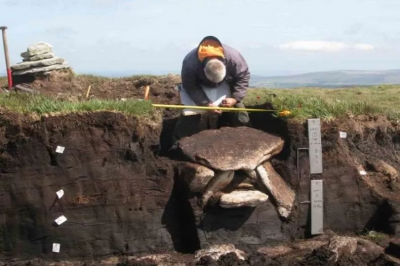 Dartmoor - Excitement has been felt among archaeologists over the discovery of a Bronze Age burial chamber on Dartmoor, which may provide fresh light on Devon’s prehistoric past. This “enchanting” discovery could rival the significance of the 2011 find at Whitehorse Hill, where the remains of a young woman dating to circa 1700 BC were discovered. Found in a secluded area to prevent tampering, the site’s exact location remains undisclosed. Peat erosion allowed for the discovery, which revealed what appears to be a Bronze Age cist or type of ancient coffin. The peat around it is waterlogged, meaning any clothing or artifacts inside could be very well preserved. The Whitehorse Hill burial was preserved in this manner, and precious artifacts including the pelt of a brown bear, 200 beads, a copper alloy pin, and a variety of other grave goods were discovered, explains the Dartmoor National Park page. Dr Bray said there were three options – to leave it where it is and let nature take its course, to try to halt the erosion or to excavate.
Dartmoor - Excitement has been felt among archaeologists over the discovery of a Bronze Age burial chamber on Dartmoor, which may provide fresh light on Devon’s prehistoric past. This “enchanting” discovery could rival the significance of the 2011 find at Whitehorse Hill, where the remains of a young woman dating to circa 1700 BC were discovered. Found in a secluded area to prevent tampering, the site’s exact location remains undisclosed. Peat erosion allowed for the discovery, which revealed what appears to be a Bronze Age cist or type of ancient coffin. The peat around it is waterlogged, meaning any clothing or artifacts inside could be very well preserved. The Whitehorse Hill burial was preserved in this manner, and precious artifacts including the pelt of a brown bear, 200 beads, a copper alloy pin, and a variety of other grave goods were discovered, explains the Dartmoor National Park page. Dr Bray said there were three options – to leave it where it is and let nature take its course, to try to halt the erosion or to excavate.
Bronze Age burial chamber discovered on Dartmoor, England - Arkeonews
HONGRIE – 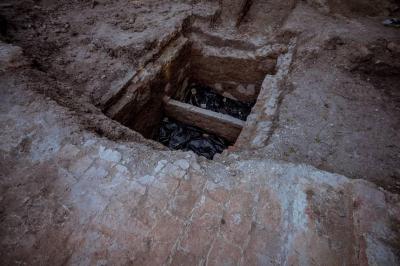 Visegrád - Situated on the banks of the Danube River, Visegrád is best known for its imposing 13th century castle that once served as a royal palace. About three years ago, local officials launched a large-scale development project to restore the castle and its surroundings. As part of the ongoing project, archaeologists excavated a tennis court near the castle — and found the ruins of a 500-year-old church, Archaeologists identified the ruins as the Church of the Virgin Mary, a Franciscan monastery founded by a Hungarian king in 1425 Excavations quickly uncovered the church’s foundation, main altar and collapsed crypt. The church’s vaulted ceiling had also crumbled at some point and was reduced to a pile of fragments, archaeologists said. Inside the collapsed crypt, archaeologists found traces of a deadly clash, the institute said. Three bodies, possibly soldiers, were found near rifle bullets and a damaged plate that was likely used as a makeshift shield. Based on the remains and artifacts, archaeologists suspect the church was looted and, in the process, became the site of a deadly confrontation. The church was probably destroyed soon after the Ottoman Empire took control of Visegrád in 1544
Visegrád - Situated on the banks of the Danube River, Visegrád is best known for its imposing 13th century castle that once served as a royal palace. About three years ago, local officials launched a large-scale development project to restore the castle and its surroundings. As part of the ongoing project, archaeologists excavated a tennis court near the castle — and found the ruins of a 500-year-old church, Archaeologists identified the ruins as the Church of the Virgin Mary, a Franciscan monastery founded by a Hungarian king in 1425 Excavations quickly uncovered the church’s foundation, main altar and collapsed crypt. The church’s vaulted ceiling had also crumbled at some point and was reduced to a pile of fragments, archaeologists said. Inside the collapsed crypt, archaeologists found traces of a deadly clash, the institute said. Three bodies, possibly soldiers, were found near rifle bullets and a damaged plate that was likely used as a makeshift shield. Based on the remains and artifacts, archaeologists suspect the church was looted and, in the process, became the site of a deadly confrontation. The church was probably destroyed soon after the Ottoman Empire took control of Visegrád in 1544
500-year-old church ruins found at tennis court in Hungary | Miami Herald
ESPAGNE – Seville - Remnants of a medieval synagogue were discovered during restoration of altarpiece in Santa Maria la Blanca church in Seville. Archeologists performing restoration work on the apse and altarpiece of the Santa Maria la Blanca church in Seville, Spain, have uncovered the remnants of a medieval synagogue Ark. According to Jewish Heritage Europe, the Ark has long been hidden by the church altar. The Ark - or the aron kodesh - is where the Torah scrolls are kept. José María Rincón, the director of the restoration, said that the Ark had been concealed by the wall-sized, gilded baroque altarpiece, built in the mid-1600s. Rincón called the discovery “a unique opportunity to witness an element unseen for 350 years, soon to be veiled once more, likely never to be seen again.” The Ark was in “an exceedingly precarious” condition, he continued. The Santa Maria la Blanca church functioned as a mosque from the 11th century until the Catholic reconquest of Seville in 1248. After this, the building became a synagogue, located in the center of the medieval Jewish quarter.
Archeologists uncover remains of ancient Spanish synagogue - The Jerusalem Post (jpost.com)
TURQUIE – 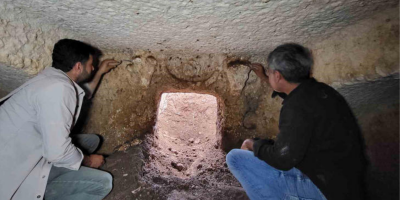 Tharsa - In Türkiye, archaeologists have discovered a new 2000-year-old tomb protected by two bull heads during excavation and cleaning efforts in the ancient city of Tharsa, Turuş Rock Tombs belong to the Roman Period. The tombs were built by carving the bedrock from the ground downwards. The tombs are reached after 10-13 steps descending downwards. There are various figures and reliefs on the walls and doorways of some rock tombs. Archaeologists said the bull’s heads were in the grave because of the belief that they would help the grave’s owner cleanse himself of evil spirits. The bull was the god Jupiter’s symbolic animal. The bull itself represents power and strength, plus a hint of unpredictability. The bull was also a symbol of the city of Athens and was depicted on many Athenian coins as a symbol of the city’s strength and power. In Roman coinage, the bull was often used to symbolize strength and fertility and was associated with the god Mars. The entrance of the tomb, dating back to the Roman and Byzantine periods, features two bull heads (bucranium) and garland decorations at the entrance, with a rosette in the center. It comprises three arcosolium. Mustafa Çelik, Deputy Director of Adıyaman Museum, said, “Tharsa Ancient City consists of 3 main archaeological areas: Big Mound, Small Mound and Necropolis Area. We started excavations in the necropolis area in 2024. We added 2 more rock tombs to the rock tombs we had previously uncovered. One of them is the rock tomb we identified today. This tomb, which consists of a main space and three arcosolium, has 2 bull’s head figures on the upper part of the entrance, which we call bukranyon in ancient times. In the middle part of the bull heads, there are decorations called girlants and rosettes.
Tharsa - In Türkiye, archaeologists have discovered a new 2000-year-old tomb protected by two bull heads during excavation and cleaning efforts in the ancient city of Tharsa, Turuş Rock Tombs belong to the Roman Period. The tombs were built by carving the bedrock from the ground downwards. The tombs are reached after 10-13 steps descending downwards. There are various figures and reliefs on the walls and doorways of some rock tombs. Archaeologists said the bull’s heads were in the grave because of the belief that they would help the grave’s owner cleanse himself of evil spirits. The bull was the god Jupiter’s symbolic animal. The bull itself represents power and strength, plus a hint of unpredictability. The bull was also a symbol of the city of Athens and was depicted on many Athenian coins as a symbol of the city’s strength and power. In Roman coinage, the bull was often used to symbolize strength and fertility and was associated with the god Mars. The entrance of the tomb, dating back to the Roman and Byzantine periods, features two bull heads (bucranium) and garland decorations at the entrance, with a rosette in the center. It comprises three arcosolium. Mustafa Çelik, Deputy Director of Adıyaman Museum, said, “Tharsa Ancient City consists of 3 main archaeological areas: Big Mound, Small Mound and Necropolis Area. We started excavations in the necropolis area in 2024. We added 2 more rock tombs to the rock tombs we had previously uncovered. One of them is the rock tomb we identified today. This tomb, which consists of a main space and three arcosolium, has 2 bull’s head figures on the upper part of the entrance, which we call bukranyon in ancient times. In the middle part of the bull heads, there are decorations called girlants and rosettes.
2000-year-old tomb guarded by two bull heads found in Tharsa Ancient City, Türkiye - Arkeonews
EGYPTE – 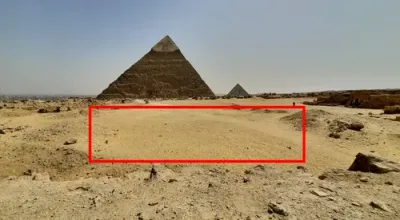 G iza - Ground-penetrating radar has helped archeologists identified buried wonders below the surface. Now, a new study from Japanese and Egyptian researchers reveals the discovery of an L-shaped structure along with an accompanying anomaly right next to the Great Pyramids of Giza. Although its impossible to know for sure what the anomaly is, the researchers guess that the L-shaped discovery could be an entrance to a deeper structure.
G iza - Ground-penetrating radar has helped archeologists identified buried wonders below the surface. Now, a new study from Japanese and Egyptian researchers reveals the discovery of an L-shaped structure along with an accompanying anomaly right next to the Great Pyramids of Giza. Although its impossible to know for sure what the anomaly is, the researchers guess that the L-shaped discovery could be an entrance to a deeper structure.
Archaeologists Found an ‘Anomaly’ Near the Pyramids That May Reveal an Ancient Portal (popularmechanics.com)
ESPAGNE – 
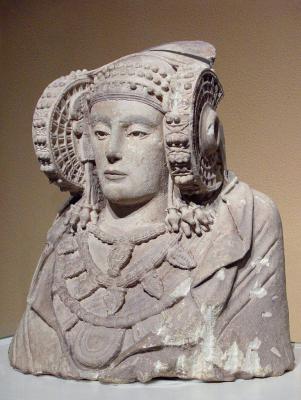 Ilici - Archaeologists from the University of Alicante and the University of Murcia “Damas y Héroes. In the project “Tras la Ilici ibérica (Ladies and Heroes. After the Iberian Ilici)” he uncovered architectural ruins in Iberia’s principal city of Ilici (modern Elche in southeastern Spain), which provide invaluable information about Iberian society and its historical context. Despite the absence of architectural remnants to corroborate the degree of Iberian society’s complexity and development, researchers were already aware of the site’s significance due to earlier discoveries, such as the well-known sculpture of the Lady of Elche. Thanks to excavations that began in 2017, remains have been found that allow a better understanding of the foundational site, which dates back to around 500 BCE. “This area was known due to the magnitude of some of the finds found, among which the sculpture of the Lady of Elche stands out without a doubt. However, we needed to find the architectural remains that would explain the importance of the Iberian groups settled there and that would allow us to know what the society of the time was like,” explains the professor of Prehistory at the University of Alicante, Alberto Lorrio, director of the project. research together with the professor of Ancient History of the University of Murcia, Héctor Uroz. As a result of the research, in addition to the city walls, eight rooms have been identified that belong to houses attached to the foundational wall, demonstrating that Ilici was one of the most important cities in the Iberian region of Contestania, which encompassed parts of the present-day provinces of Alicante, Murcia, Albacete, and Valencia. This new information confirms that La Alcudia was home to the first metropolis, the first major Iberian city in Contestania. The enclave discovered in l’Alcúdia is “the first metropolis, the first large Iberian city of the Contestania, and the oldest. There is no older one of this magnitude,” says Professor Uroz.
Ilici - Archaeologists from the University of Alicante and the University of Murcia “Damas y Héroes. In the project “Tras la Ilici ibérica (Ladies and Heroes. After the Iberian Ilici)” he uncovered architectural ruins in Iberia’s principal city of Ilici (modern Elche in southeastern Spain), which provide invaluable information about Iberian society and its historical context. Despite the absence of architectural remnants to corroborate the degree of Iberian society’s complexity and development, researchers were already aware of the site’s significance due to earlier discoveries, such as the well-known sculpture of the Lady of Elche. Thanks to excavations that began in 2017, remains have been found that allow a better understanding of the foundational site, which dates back to around 500 BCE. “This area was known due to the magnitude of some of the finds found, among which the sculpture of the Lady of Elche stands out without a doubt. However, we needed to find the architectural remains that would explain the importance of the Iberian groups settled there and that would allow us to know what the society of the time was like,” explains the professor of Prehistory at the University of Alicante, Alberto Lorrio, director of the project. research together with the professor of Ancient History of the University of Murcia, Héctor Uroz. As a result of the research, in addition to the city walls, eight rooms have been identified that belong to houses attached to the foundational wall, demonstrating that Ilici was one of the most important cities in the Iberian region of Contestania, which encompassed parts of the present-day provinces of Alicante, Murcia, Albacete, and Valencia. This new information confirms that La Alcudia was home to the first metropolis, the first major Iberian city in Contestania. The enclave discovered in l’Alcúdia is “the first metropolis, the first large Iberian city of the Contestania, and the oldest. There is no older one of this magnitude,” says Professor Uroz.
Archaeological excavations unearthed the first great Iberian city in Contestania and the oldest one - Arkeonews
GRECE – 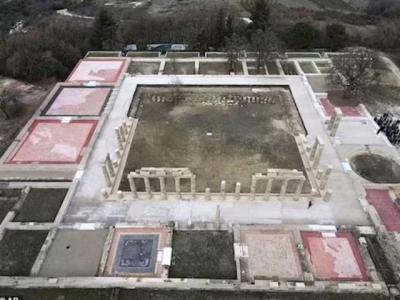 Aigai - Archaeologists say to have unearthed Alexander the Great’s bathroom at the Aigai Palace in northern Greece. The vast Aigai palace, which covers 15,000 square meters and is larger than the Parthenon, is located in the ceremonial center of the ancient Macedonian kingdom. The excavations also discovered the palaestra, or combat-sport gymnasium, where Alexander trained, located adjacent to his bathing facilities.
Aigai - Archaeologists say to have unearthed Alexander the Great’s bathroom at the Aigai Palace in northern Greece. The vast Aigai palace, which covers 15,000 square meters and is larger than the Parthenon, is located in the ceremonial center of the ancient Macedonian kingdom. The excavations also discovered the palaestra, or combat-sport gymnasium, where Alexander trained, located adjacent to his bathing facilities.
Alexander the Great’s Bathroom Discovered at Greece's Aigai Palace - Arkeonews
ALBANIE – 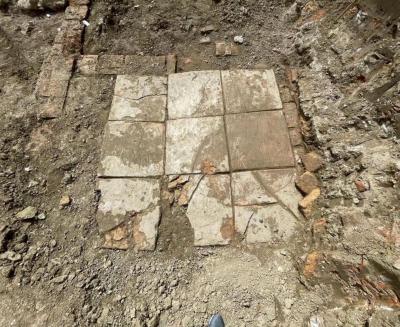
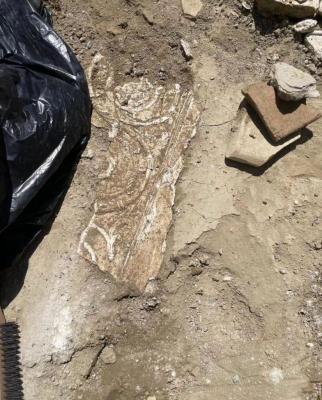 Durrës - In the Albanian port city of Durrës, archaeologists have uncovered a 1600-year-old Roman indoor pool, the first of its kind. Durrës is Albania’s oldest economic and historic center, having emerged as a permanent gate between the east and the west. The city was known as Epidamnus by the Illyrians in the seventh and sixth centuries BC. The Greeks colonized the city in 672 BC and called it “Dyrrhachium,” or “The city between the two hills.” The Romans took over the city around 230 BC. The city was known to the Roman historian Catullus as “Dyrrhachium Adria e Taberna,” or “The Adriatic Tavern.” Cicero, who took refuge in Durrës circa 57 BC, described the city as “admirable,” mainly because of his colorful and active lifestyle. The archaeologists of the city of Durres are familiar with Roman remains, but the latest discovery surprised even them. Among the ruins of an ancient Roman villa were traces of an indoor pool decorated with well-preserved mosaics, the institute said. “From the excavations, the remains of an indoor swimming pool of a Roman period residence were discovered, the first of its kind discovered in Albania. It is decorated on its entire surface with colorful frescoes of a high artistic level.” The Institute underlined that the most important feature of the building is that it has a very well-preserved mosaic floor with geometric motifs made of marble, stone, glass, and ceramic tiles. Archaeologists estimated that the Roman ruins were between 1 and 400 A.D. old, and at least 1,600 years old. According to the institute, excavations at a different part of the site revealed several walls and a sizable brick floor that may be the remnants of a two-story ancient Roman bathhouse. Other fragments of walls, ceilings, and tile mosaics were also uncovered.
Durrës - In the Albanian port city of Durrës, archaeologists have uncovered a 1600-year-old Roman indoor pool, the first of its kind. Durrës is Albania’s oldest economic and historic center, having emerged as a permanent gate between the east and the west. The city was known as Epidamnus by the Illyrians in the seventh and sixth centuries BC. The Greeks colonized the city in 672 BC and called it “Dyrrhachium,” or “The city between the two hills.” The Romans took over the city around 230 BC. The city was known to the Roman historian Catullus as “Dyrrhachium Adria e Taberna,” or “The Adriatic Tavern.” Cicero, who took refuge in Durrës circa 57 BC, described the city as “admirable,” mainly because of his colorful and active lifestyle. The archaeologists of the city of Durres are familiar with Roman remains, but the latest discovery surprised even them. Among the ruins of an ancient Roman villa were traces of an indoor pool decorated with well-preserved mosaics, the institute said. “From the excavations, the remains of an indoor swimming pool of a Roman period residence were discovered, the first of its kind discovered in Albania. It is decorated on its entire surface with colorful frescoes of a high artistic level.” The Institute underlined that the most important feature of the building is that it has a very well-preserved mosaic floor with geometric motifs made of marble, stone, glass, and ceramic tiles. Archaeologists estimated that the Roman ruins were between 1 and 400 A.D. old, and at least 1,600 years old. According to the institute, excavations at a different part of the site revealed several walls and a sizable brick floor that may be the remnants of a two-story ancient Roman bathhouse. Other fragments of walls, ceilings, and tile mosaics were also uncovered.
A 1,600-year-old indoor pool, the first of its kind, discovered in Albania - Arkeonews